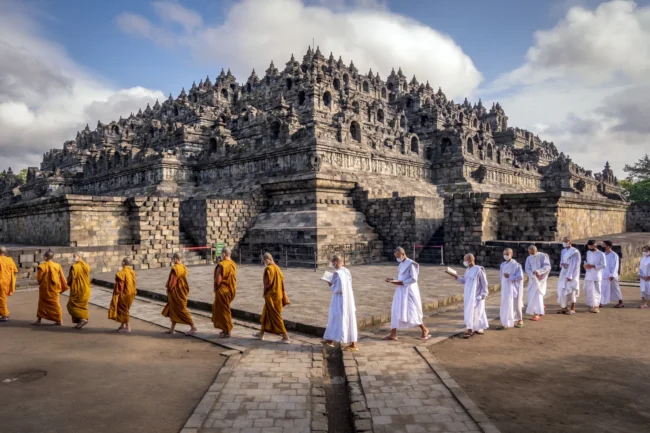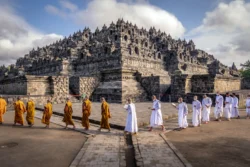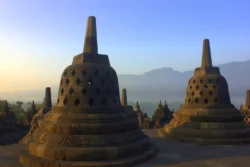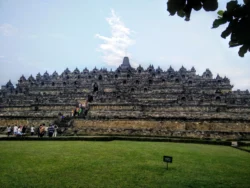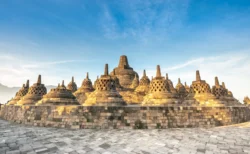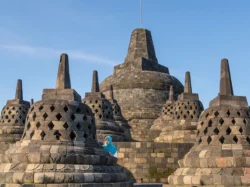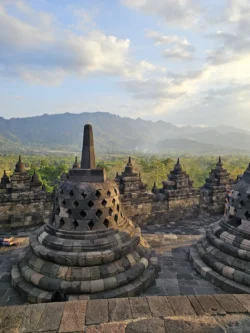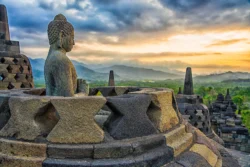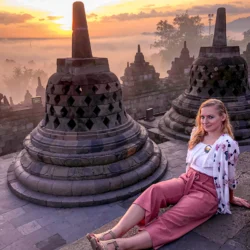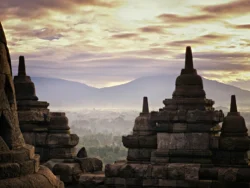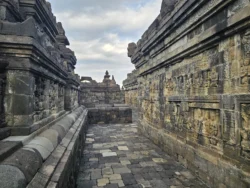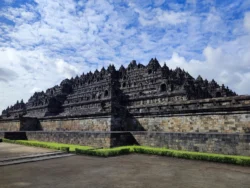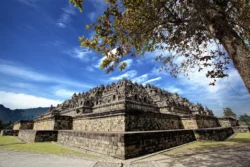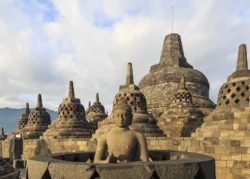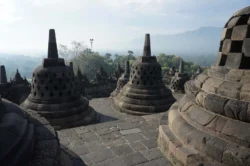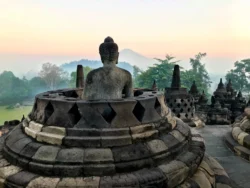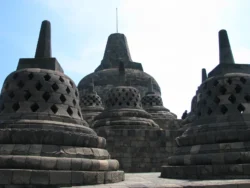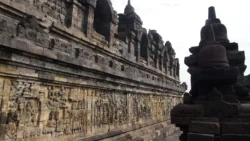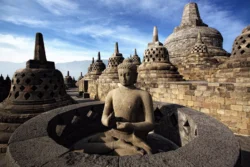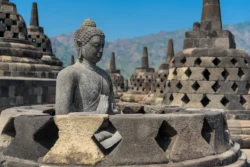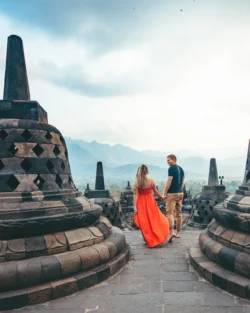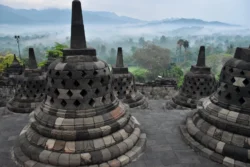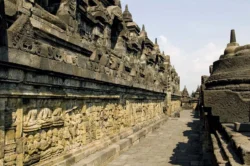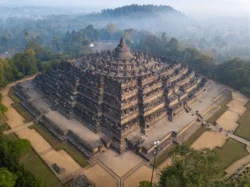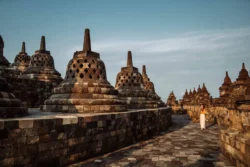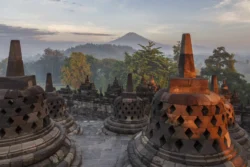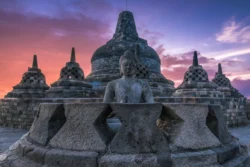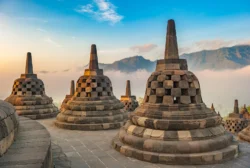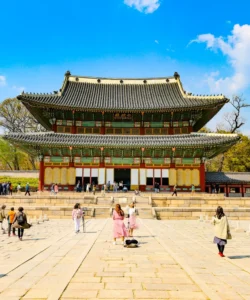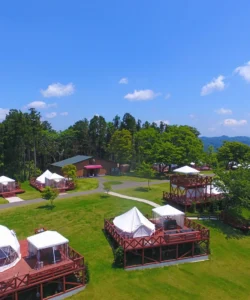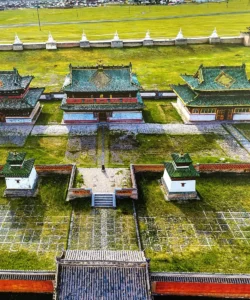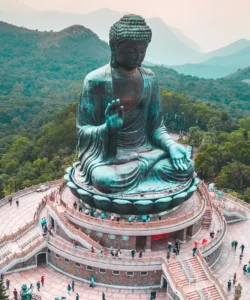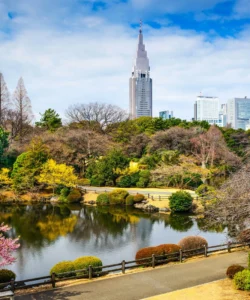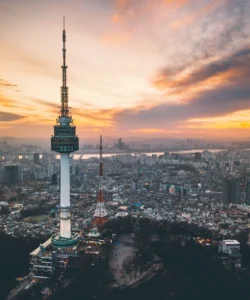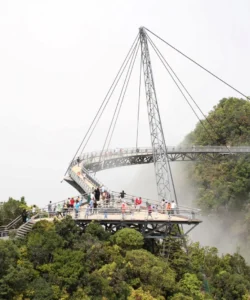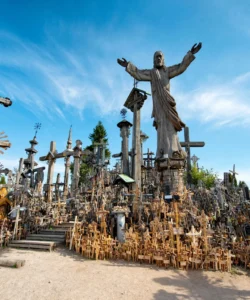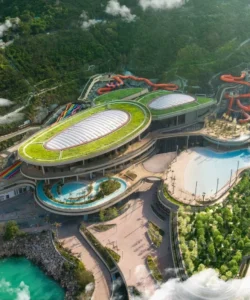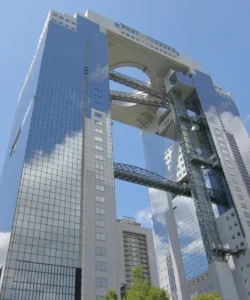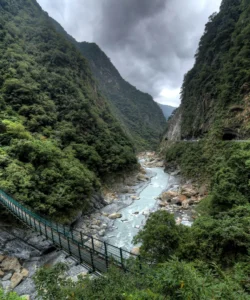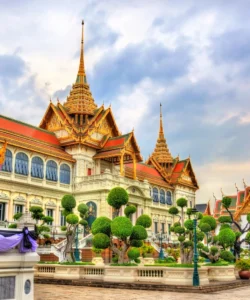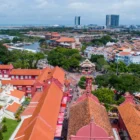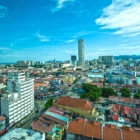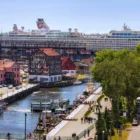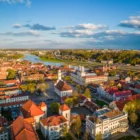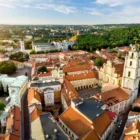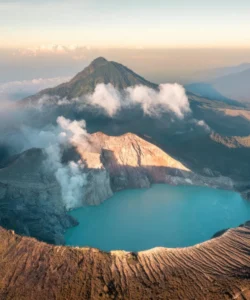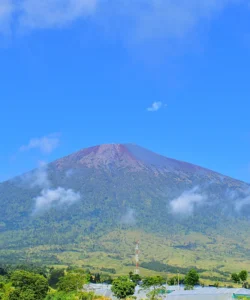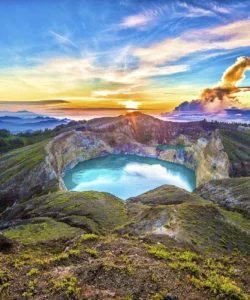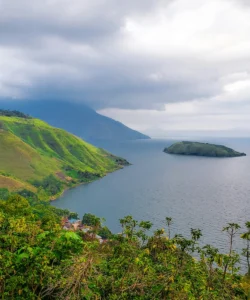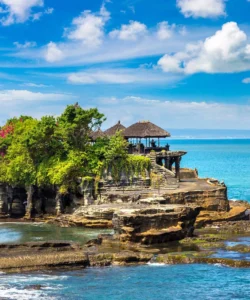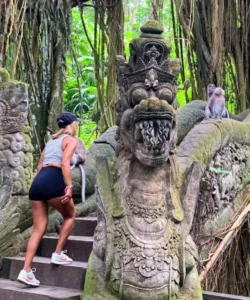Borobudur Temple is not just a structure; it’s a profound spiritual journey carved in stone, a massive testament to Mahayana Buddhist philosophy and ancient Javanese artistry. Rising majestically from the Kedu Plain in Central Java, Indonesia, it is widely recognized as the world’s largest Buddhist temple and one of the most magnificent ancient monuments on Earth.
Name: Borobudur Temple (Indonesian: Candi Borobudur; Javanese: Candhi Barabudhur)
Address: Jl. Badrawati, Kw. Candi Borobudur, Borobudur, Magelang Regency, Central Java, Indonesia.
It is located approximately 40 km (25 miles) northwest of Yogyakarta and 86 km (53 miles) west of Surakarta, situated in a valley between two volcanoes (Mt. Sundoro-Sumbing and Mt. Merbabu-Merapi) and two rivers (Progo and Elo).
How to Get There:
Most visitors access Borobudur from Yogyakarta, the cultural heart of Central Java.
- By Air: The closest major airport is Yogyakarta International Airport (YIA). From there, you can take a pre-booked taxi, Grab/Gojek (ride-sharing apps), or a local bus.
- From Yogyakarta City to Borobudur:
- Private Car with Driver (Recommended): This offers the most comfort and flexibility, allowing for early morning sunrise visits. Many tour operators and hotels in Yogyakarta offer this service. The drive takes about 1.5 – 2 hours.
- Bus (Budget-Friendly): Take a TransJateng bus or a local minibus from Jombor Bus Terminal in northern Yogyakarta directly to Borobudur Terminal (approx. 1.5-2 hours). From Borobudur Terminal, it’s a short 10-minute walk or a quick becak (pedicab) ride to the temple entrance.
- Taxi/Ride-Hailing Apps (Grab/Gojek): Convenient for direct transport, though more expensive than buses.
- Motorbike Rental: For adventurous and experienced riders, renting a motorbike in Yogyakarta is an option, offering flexibility to explore the surrounding area.
- Temple Access: Note that typically, you buy a “Temple Ground Ticket” for access to the park. To access the temple structure itself (to climb to the upper levels), you usually need to purchase a separate “Temple Structure Ticket” which often includes a guided tour and requires you to wear special flip-flops provided by the park. It’s advisable to book these structure access tickets in advance, especially for morning sessions.
Landscape and Architecture:
Borobudur’s architecture is a magnificent three-dimensional representation of Buddhist cosmology, seamlessly integrated with its natural surroundings.
- Giant Stupa and Mandala Design: From above, Borobudur takes the form of a giant tantric Buddhist mandala, representing the Buddhist cosmology and the nature of mind. It is built as a single large stupa, approximately 118 meters (387 ft) on each side at its base.
- Nine Stacked Platforms: The monument is constructed on a natural hill and features nine stacked platforms: the lower six are square, and the upper three are circular. This terraced structure is reminiscent of the prehistoric Austronesian megalithic step pyramids (punden berundak) found in Indonesia, blending indigenous beliefs of ancestral spirits residing on high places with Buddhist concepts.
- Buddhist Cosmology Embodied: The vertical division of the temple perfectly accords with Buddhist cosmology:
- Kamadhatu (Realm of Desire): Represented by the base, with hidden reliefs depicting the law of cause and effect (Karmawibhangga Sutra).
- Rupadhatu (Realm of Form): The five square terraces, adorned with galleries of intricate bas-relief sculptures.
- Arupadhatu (Realm of Formlessness): The three circular platforms, sparsely decorated, leading to the ultimate goal of enlightenment.
- 2,672 Bas-Relief Panels: The walls and balustrades of the square terraces are adorned with an astounding 2,672 meticulously carved bas-relief panels, covering a total surface area of 2,520 square meters (over 5 kilometers if stretched end-to-end). These reliefs depict stories from the life of Buddha (Lalitavistara, Jataka/Avadana), Buddhist teachings (Gandavyuha), and scenes of daily Javanese life from the 8th and 9th centuries. They are meant to be “read” in a clockwise circumambulation (pradaksina) as pilgrims ascend the monument.
- 504 Buddha Statues: The temple is decorated with 504 Buddha statues. On the square terraces, Buddhas are placed in niches, while on the three circular platforms, there are 72 smaller perforated stupas, each containing a Buddha statue visible through the bell-shaped openings. The large central stupa crowns the monument at the very top.
- Construction Without Mortar: The monument was constructed using over 55,000 cubic meters of andesite stone, quarried from nearby volcanic deposits. The stones were cut, shaped, and interlocked using knobs, indentations, and dovetails, largely without the use of mortar, a remarkable engineering feat. A sophisticated drainage system with over 100 gargoyles (Makaras) was also integrated.
- Mountain and River Setting: The temple stands on a hill, surrounded by the majestic silhouettes of volcanoes (Merapi, Merbabu, Sumbing, Sindoro, Menoreh Hills) and the Progo and Elo rivers, creating a breathtaking panoramic view from its summit, especially at sunrise.
What Makes It Famous:
- World’s Largest Buddhist Temple: Borobudur is universally recognized as the largest Buddhist temple globally, a monumental achievement of ancient architecture and religious devotion.
- UNESCO World Heritage Site: Inscribed in 1991, it’s celebrated for being a masterpiece of Buddhist architecture and monumental arts, and an outstanding example of Indonesia’s 8th-9th century art and architecture.
- Iconic Sunrise Experience: Witnessing the sunrise from the top of Borobudur, as the mist lifts over the surrounding volcanoes and the first rays illuminate the stupas and Buddha statues, is a world-famous and deeply spiritual experience.
- Extensive Bas-Reliefs: Its unparalleled collection of over 2,600 narrative bas-reliefs makes it one of the world’s most comprehensive visual narratives of Buddhist teachings and ancient Javanese life.
- Symbolic Spiritual Journey: The temple’s design itself is a three-dimensional mandala, a pilgrimage path that guides devotees through the realms of Buddhist cosmology towards enlightenment, offering a profound spiritual experience even for non-Buddhists.
- Architectural and Engineering Marvel: Its construction without mortar, sophisticated drainage system, and the sheer scale and intricacy of its carvings demonstrate extraordinary ancient engineering and artistic skill.
- Hidden for Centuries: The temple was abandoned and lay hidden under volcanic ash and jungle growth for centuries, only to be rediscovered in the 19th century by Sir Stamford Raffles, adding a layer of mystery and rediscovery to its history.
Differences from Some Other Wonders:
- Buddhist Temple and Pilgrimage Site: Unlike George Town or Malacca City (which are multicultural trading cities), or natural wonders like Mount Kinabalu, Borobudur is primarily a massive Buddhist temple and active pilgrimage site. Its entire design is a spiritual diagram.
- Layered, Ascending Structure: While other temples (like Angkor Wat or Prambanan) are sprawling complexes on a horizontal plane, Borobudur is a single, tiered, ascending structure built around a hill, guiding the pilgrim upwards through symbolic realms. This vertical journey is a key architectural and spiritual differentiator.
- Bas-Relief Storytelling: While many ancient sites have reliefs, Borobudur’s quantity and the continuous narrative flow of its bas-reliefs, meant to be “read” in a specific circumambulatory path, are exceptionally comprehensive and serve as a “textbook in stone” for Buddhist doctrine.
- No Interior Spaces/Rooms for Worship: Unlike many temples or cathedrals that feature large interior halls or chambers for worship, Borobudur is largely an open-air monument composed of terraces and stupas, designed for outdoor circumambulation and meditation.
- Integration of Indigenous Beliefs: The blend of indigenous Javanese terraced mountain worship (punden berundak) with Mahayana Buddhist cosmology in its design is a unique syncretic feature that distinguishes it from purely Indian or East Asian Buddhist architectural styles.
- Focus on a Single Monument: While part of a larger compound with Mendut and Pawon temples, Borobudur’s fame largely rests on the grandeur and significance of this single, unified monument, rather than a sprawling complex of many buildings.
- Restoration Success Story: Its major 20th-century restoration project, a collaborative effort between the Indonesian government and UNESCO, is considered one of the most successful and complex archaeological conservation projects globally, bringing it back from near ruin.
Borobudur Temple Photos:
